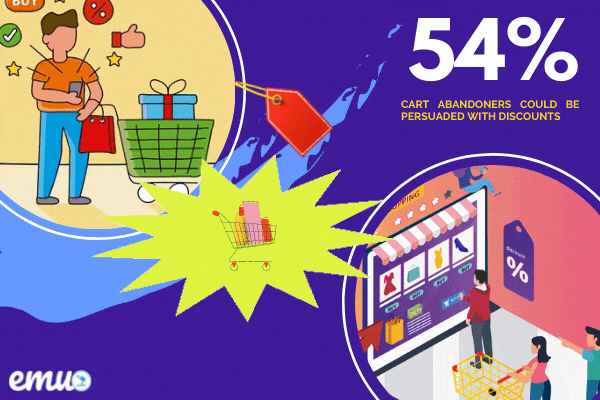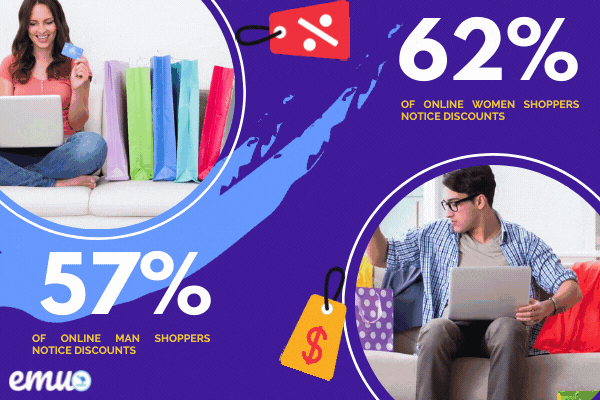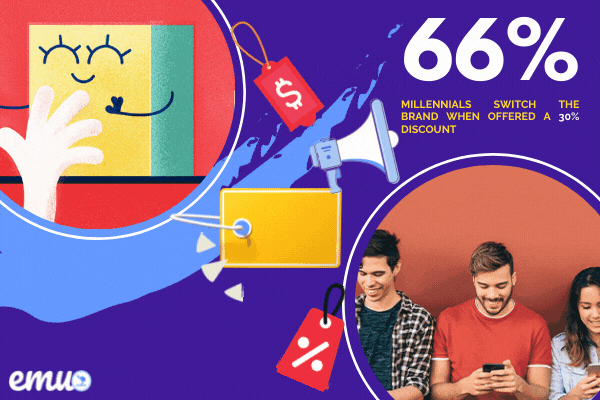Everyone loves a good deal and heavy discounts, whether it's something of need or not—and there are no two ways about it! Whether we think of ourselves as cool-headed and logical, but the truth is we act by no means rational. At times, our actions are contradictory to reason and extremely unexpected ways. Regardless of considering ourselves as rational animals, we have gone way too far when it comes to sales.
We crave discounts, and when we get them, we go ape and end up buying things we do not need. The psychology of discounts reveals how deals not only capture our attention but also significantly influence what we decide to purchase.
Nearly all the retailers, these days, use discounts and coupon strategies to grow their audience and revenue. Brands that understand consumer behavior and the psychology of discounts successfully create a positive business image, enhance customer satisfaction, and drive higher sales.
Let’s dive into the differences that discounts and deals make in our buying decisions and behaviors.
Although, all the factors discussed above are important in constituting the consumer behavior as fast as online shopping is concerned. However, discounts seem to play a very pivotal role in shaping the buying decision. Websites flaunting discounts and coupons are experiencing more traffic as compared to those with expansive, undiscounted items. Consumers are more eager to buy, let’s say sports items, from the store offering a 20% discount than a renowned brand such as NIKE or MRP.
Sometimes, customers might feel a little skeptical about the quality of the goods they are buying online. Therefore, they give preference to renowned brands over those they don’t trust much, even if that costs them more money. Additionally, discounts may work extremely well at magnetizing the customers but raise the expectations for customers as well, making them look for heavy discounts every time they shop. This above talk are the main components of phycology of discounts.
Here is what you need to know about customer behavior and discounts.
- 83% of buyers are somewhat likely or very likely to click an ad offering a discount or promotion
Taglines, such as “limited time offer” or “offer valid till tomorrow“ create a sense of urgency, which is why marketers more and more use these terms when presenting their discount offers. The idea behind this is to make the potential buyer feel as if s/he is going to lose a valuable deal without rationalizing whether the discounted item is of his or her use or not. Since the feeling of losing something make us more poignant than the joy of winning it, we turn all the stones to prevent missing out on a good discount.
Believe it or not, shoppers are now more and more expecting their favorite brands to offer discounts, and getting one makes them delighted and contented, no matter how big or small is the difference between actual and discounted price. Getting an unexpected coupon or deal from a retailer that barely doles out discounts can trigger an exciting shopping spree.
- Over 64% of online consumers wait to buy things until they go for sale
Customers wait for discounts, and statistics surely back this theory. At times, people hold their horses when it comes to buying certain products and wait for items to be put on sale. Let’s say, some consumers do not wait for winter to do winter shopping, instead, they look for sale on winter items as spring season kicks off. Since the demand for winter clothing is low in spring, therefore many brands offer high-quality, expansive winter items at discounted prices under the label of clearance sale.
As soon as holidays like Christmas and events like Cyber Monday or Black Friday approaches, retailers offer heavy discounts. This makes people wait for these times of the year to do shopping.
While these holiday-based discounts are expected to bring in sales for the retailers at the end of the year, they have raised customers’ expectations towards discounts. Customers now expect discounts and holiday coupons from all renowned and big-box brands such as Walmart and Target.
- 22% of consumers purchase products from their preferred brands online when on sale or with a coupon
The competition between retailers and brands over the internet is so fierce that disincentivizing consumers to seek discounts anywhere else works well. Providing discounts or deals to consumers can deter them from looking for the same item elsewhere online. The sense of urgency that discounts create can distract the buyer from searching for alternative retailers.
The thing to note here is that most of the successful brands bolster their revenue using multiple channels. Keeping tabs on their shoppers and knowing who will gladly pay full price and who waits for a deal to surface up. These brands deliver exclusive discounts to each segment of their customer base, eventually fortifying their bottom line.
- 54% of shoppers buy products left in shopping carts when they are offered at a discounted price
People are, most of the time, ready to spring for a bargain. Dropped prices on their desired yet abandoned products shopping cart, increase the chances for them to buy the items. However, 56% claimed that their primary reason to abandon the cart was that their discount code does not work (Statista). Retailers can use the discounts on their products as a bargaining chip. It might not hurt to gain a sale by reducing the prices a tad.
- 30% of consumers use price tracking services to get notified about discounts
In this tech-driven era, having internet-savvy consumers or we should say the “smart consumers”, brands cannot overprice their products. are on the rise. Now we have all the information at our fingertips and consumers are quite interested in product comparisons before making their purchase decisions. Obviously, they won’t compare every time they buy a product, especially when the price is not much. People may compare the prices of their soon-to-be-bought electronics beauty products and automobiles, but they won't do the same when buying a detergent or toothpaste.
Brands can get the best out of the price comparing websites by creating partnerships with these sites. It will benefit both the consumers and the brands as customers will be able to get more options and convenience, whereas the brands will get a profitable acquisition channel.
- Around 62% of online women shoppers notice discounts as compared to 57% of online men shoppers
Men are not generally considered a viable target audience for certain products related to the household industry, and eventually for discounts. Nevertheless, we have seen drastic changes in societal gender roles over the last few decades. Today, men can serve as potential consumers when it comes to different product categories.
Categories concerning cosmetics, fashion, and healthy foods are mostly the choice of female customers, whereas men are more interested in buying products relating to the categories like tech gadgets, shoes, and fitness gear. Retailers can keep these stats and facts in check and use these efficiently in future promotions. Many brands serving in these niches are coming up with several campaigns to skyrocket their profit and personalizing their discount codes as per their targeted audience.
- 66% of millennial switch the brand when offered a 30% discount
Millennials stay focused on discounts while shopping. For them, price tops every other factor, be it a brand image, product quality, or recommendations. They browse the internet in search of discounts.
Besides, the sole purpose of any coupon or discount deal is to encourage customers to buy the product. People do not usually feel so welcoming when they encounter new products. They respond paradoxically to newness. Besides, they also have a resistive reaction to things they are not familiar with. Colorful ads themselves are not enough to woo them, instead, they look for an incentive to ignore their current taste for a while and try something new.
Considering it as a new financial powerhouse generation, retailers need to assess what sparks the shopping behavior in millennials and make necessary changes to their marketing strategies.
To Wrap Up
Customers look for ways to save money and discounts provide just that. Customer discount programs successfully entice consumers to make a purchasing decision and reinforce purchasing behaviors. As emotional creatures, customers prefer to accept discount offers on paying fully for something. They believe that they are getting on the winning side when they walk away paying less on the overall purchase.
Coupons play a crucial role in how discounts affect consumer behavior by influencing purchasing decisions. Yes! They alone cannot drive sales, as the quality of the product matters the most. However, considering the growing competition, markers and businesses should take note of these impacts and use them while pushing their promotions.







